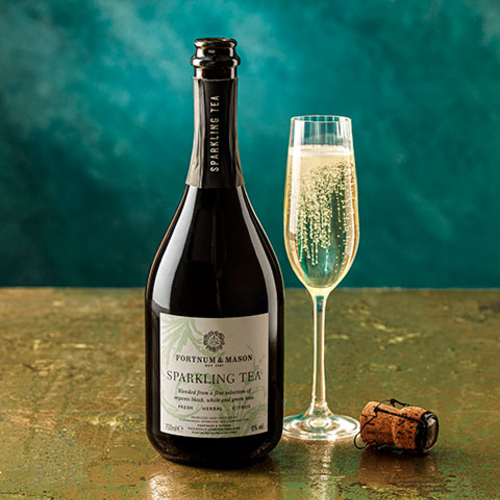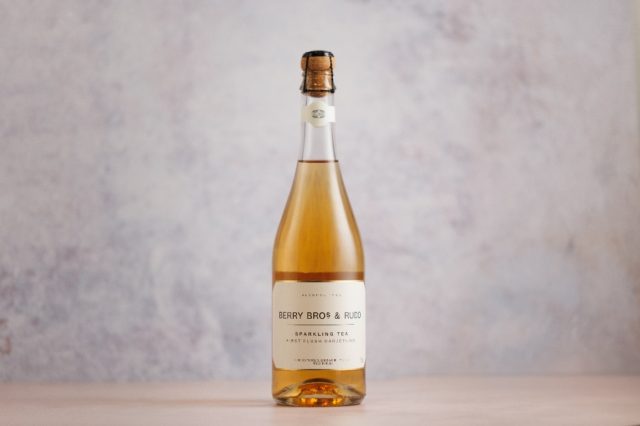How sparkling tea is taking on ‘Champagne moments’
Sparkling tea has become “the perfect fit for Champagne moments”, according to the wine buyer at London’s luxury department store Fortnum & Mason. Victoria Moore looks at how this breakout product has become phenomenally successful.

High on Mount Liushidan, which is famous for the daylilies that cover its slopes with orange blooms, a tiny tea garden looks out across the craggy ridges of Taiwan. The tea that grows here is exquisite and when Charlie Winkworth-Smith of Saicho Drinks tasted it, he knew he wanted it for the first in a new limited-edition range of sparkling teas.
Saicho Sparkling Tea Sixty Stone Mountain Rare Tea Collection (Sixty Stone is the literal translation of Liushidan) launched last month. Its price – it is £60 a bottle – is a mark of how sophisticated the sparkling tea element of the no and low market has become.
Sparkling tea, as we know it today, is a relatively new category, a breakout product that has become phenomenally successful very quickly and is still growing at pace. It has its roots in kombucha, fermented tea, which some say originated in China thousands of years ago and others say, we just don’t know where it comes from or when. Today those drinks labelled “sparkling tea” might be fermented, like Real Drinks which rebranded its products from Real Kombucha to Real Sparkling Fermented Tea in 2022. But they might not. For instance, Saicho sparkling teas are not fermented, they have bubbles because they are carbonated.
If modern “sparkling teas” have anything in common that distinguishes them all from old-school kombucha in one corner, and Liptons Iced Sparkling Tea in another, it’s probably a clarity and elegance of flavour.
Demand at some of the most upmarket retailers, restaurants and hotels shows there’s a raging thirst for the new sparkling tea. Berry Bros & Rudd has just announced the launch of its first own-label sparkling tea, an exclusive blend created with The REAl Co.

Meanwhile, round the corner from St James St, on Piccadilly, Fortnum & Mason customers are already big fans. “For the last two years, Fortnum’s Sparkling Tea [which is made by Copenhagen Sparkling Tea] has represented more than one in five of all sparkling options sold, including all Champagne, Sparkling Wines and Sparkling Tea,” says Oscar Dodd, Wine & Spirits Buyer at Fortnum & Mason. “We are on course for a similar mix this year, showing how quickly sparkling tea has become a key category for Fortnum’s. Customers buy it as much to drink themselves as they do to gift, which we’re really proud of. We’re about to land our first shipment of Fortnum’s Original Sparkling Tea in Magnum [£45/150cl] and are working on half bottles for launch later in 2025.”
Partner Content
As Dodd says, part of the appeal of sparkling tea is that it’s a perfect fit for Champagne moments. “[It echoes] the celebratory Champagne ritual – chill the bottle, pop the cork, pour it into a flute…”
There are also obvious parallels with fine wine. The taste of tea and grapes is highly dependent on terroir so we can talk about tiny tea gardens or enclosed vineyards, wider regions or PDOs. Each produces a highly nuanced drink, with complexity and heritage – and tannin.
The location of sparkling tea company Real Drinks’ fermentery, on the Rothschild Waddesdon Estate, encourages this association. While the Copenhagen Sparkling Tea Company was created by a sommelier, Jacob Cocemba, who couldn’t find the perfect match for a particular dessert from the 1,700-bottle strong cellar of the restaurant in which he was then working, so made one, using a blend of fine teas. Likewise, it was the search for a drink that could replace wine in a wine and food pairing dinner that led Charlie Winkworth-Smith and his partner, Natalie Chiu, who doesn’t drink alcohol, to found Saicho Drinks back in 2017.
“Yes, we originally created Saicho for fine dining,” says Winkworth-Smith, who has several pairing ideas up his sleeve that make mouth-wateringly good sense. He recommends drinking the Sixty Stone Mountain, which is rich and honeyed, with miso black cod or glazed pork. The Saicho line that I see most sommeliers veer towards is Hojicha. Made with roasted green tea from Japan, cold-brewed and sweetened with white tea juice, Saicho Hojicha has an umami-like richness and a tang that appeals to searching professional palates, that are geared to revel in complexity. Winkworth-Smith recommends pairing Hojicha with sushi or mushroom risotto.
The versatility of its different cuvées means that Saicho is increasingly used on pairing menus, including, recently, at Counter 71 in London’s Shoreditch.
But, says Winkworth-Smith, sparkling tea has really taken on a life of its own. Saicho is now listed in 60 Michelin-starred restaurants around the globe, including Core by Clare Smyth. It’s now in 15 different countries, having launched in Australia this month [November] and demand has grown in a number of different areas. One of those is on the back-bar.
“Cocktails are becoming a bigger thing. Tea has a beautiful, complex flavour and the bitterness and tannin in the structure adds a lot to the cocktail.” Winkworth-Smith continues, “We’re also seeing an increase in demand for Saicho for brunch menus, hotel amenities and gifting. But what has really become our signature serve is afternoon tea.”
The afternoon tea serve doesn’t replace a traditional cuppa. It replaces the glass of Champagne with which a luxe afternoon tea begins. So at London’s Peninsula Hotel, where the Afternoon Tea menu in The Lobby is £95, guests can choose from a glass of English sparkling wine [Coates & Seely], a glass of Saicho Darjeeling Sparkling Tea or a gin [Cambridge 1928] and tonic to sip alongside the coronation chicken sandwiches and lobster thermidor tart.
“In the Mandarin Oriental,” says Winkworth-Smith, “They actually do a pairing afternoon tea, with one of our mini bottles paired with each course.”
The question with any trend is always – where next? It’s one that Saicho looks to be trying to answer with its launch of Sixty Stone Mountain and its move into rare sparkling teas. And as people all over the world reduce their alcohol intake without, perhaps, losing their appetite for flavour and socialising, I can only say, rare sparkling tea? Why not?
Related news
Hong Kong’s leading hotels capitalise on the sparkling tea trend
Saicho sparkling tea: giving fine wine pairings a run for their money




